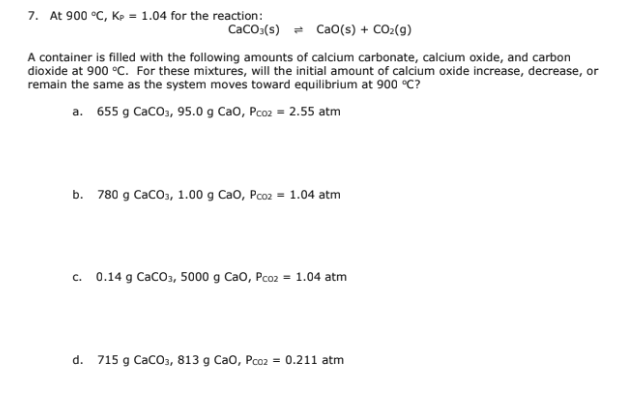7. At 900 °C, Kp = 1.04 for the reaction: CaCO3(s) CaO(s) + CO₂(g) A container is filled with the following amounts of calcium carbonate, calcium oxide, and carbon dioxide at 900 °C. For these mixtures, will the initial amount of calcium oxide increase, decrease, or remain the same as the system moves toward equilibrium at 900 °C? a. 655 g CaCO3, 95.0 g CaO, Pco2 = 2.55 atm b. 780 g CaCO³, 1.00 g CaO, Pco2 = 1.04 atm c. 0.14 g CaCO3, 5000 g CaO, Pco2 = 1.04 atm d. 715 g CaCO3, 813 g CaO, Pco2 = 0.211 atm
7. At 900 °C, Kp = 1.04 for the reaction: CaCO3(s) CaO(s) + CO₂(g) A container is filled with the following amounts of calcium carbonate, calcium oxide, and carbon dioxide at 900 °C. For these mixtures, will the initial amount of calcium oxide increase, decrease, or remain the same as the system moves toward equilibrium at 900 °C? a. 655 g CaCO3, 95.0 g CaO, Pco2 = 2.55 atm b. 780 g CaCO³, 1.00 g CaO, Pco2 = 1.04 atm c. 0.14 g CaCO3, 5000 g CaO, Pco2 = 1.04 atm d. 715 g CaCO3, 813 g CaO, Pco2 = 0.211 atm
Chemistry & Chemical Reactivity
9th Edition
ISBN:9781133949640
Author:John C. Kotz, Paul M. Treichel, John Townsend, David Treichel
Publisher:John C. Kotz, Paul M. Treichel, John Townsend, David Treichel
Chapter15: Principles Of Chemical Reactivity: Equilibria
Section: Chapter Questions
Problem 3PS: Kc = 5.6 1012 at 500 K for the dissociation of iodine molecules to iodine atoms. I2(g) 2 I(g) A...
Related questions
Question
100%

Transcribed Image Text:7. At 900 °C, Kp = 1.04 for the reaction:
CaCO3(s)
CaO(s) + CO₂(g)
A container is filled with the following amounts of calcium carbonate, calcium oxide, and carbon
dioxide at 900 °C. For these mixtures, will the initial amount of calcium oxide increase, decrease, or
remain the same as the system moves toward equilibrium at 900 °C?
a.
655 g CaCO3, 95.0 g CaO, Pco2 = 2.55 atm
b.
780 g CaCO3, 1.00 g CaO, Pco2 = 1.04 atm
c. 0.14 g CaCO3, 5000 g CaO, Pco2 = 1.04 atm
d. 715 g CaCO3, 813 g CaO, Pco2 = 0.211 atm
Expert Solution
This question has been solved!
Explore an expertly crafted, step-by-step solution for a thorough understanding of key concepts.
Step by step
Solved in 5 steps with 5 images

Knowledge Booster
Learn more about
Need a deep-dive on the concept behind this application? Look no further. Learn more about this topic, chemistry and related others by exploring similar questions and additional content below.Recommended textbooks for you

Chemistry & Chemical Reactivity
Chemistry
ISBN:
9781133949640
Author:
John C. Kotz, Paul M. Treichel, John Townsend, David Treichel
Publisher:
Cengage Learning

Chemistry & Chemical Reactivity
Chemistry
ISBN:
9781337399074
Author:
John C. Kotz, Paul M. Treichel, John Townsend, David Treichel
Publisher:
Cengage Learning


Chemistry & Chemical Reactivity
Chemistry
ISBN:
9781133949640
Author:
John C. Kotz, Paul M. Treichel, John Townsend, David Treichel
Publisher:
Cengage Learning

Chemistry & Chemical Reactivity
Chemistry
ISBN:
9781337399074
Author:
John C. Kotz, Paul M. Treichel, John Townsend, David Treichel
Publisher:
Cengage Learning


Chemistry: An Atoms First Approach
Chemistry
ISBN:
9781305079243
Author:
Steven S. Zumdahl, Susan A. Zumdahl
Publisher:
Cengage Learning

Chemistry
Chemistry
ISBN:
9781305957404
Author:
Steven S. Zumdahl, Susan A. Zumdahl, Donald J. DeCoste
Publisher:
Cengage Learning

General Chemistry - Standalone book (MindTap Cour…
Chemistry
ISBN:
9781305580343
Author:
Steven D. Gammon, Ebbing, Darrell Ebbing, Steven D., Darrell; Gammon, Darrell Ebbing; Steven D. Gammon, Darrell D.; Gammon, Ebbing; Steven D. Gammon; Darrell
Publisher:
Cengage Learning